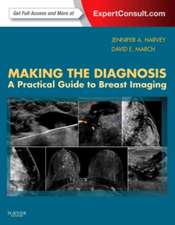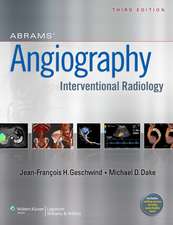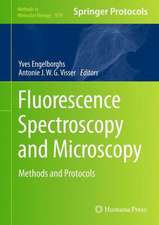Imaging Tumor Response to Therapy
Editat de Massimo Aglietta, Daniele Reggeen Limba Engleză Hardback – 8 iun 2012
| Toate formatele și edițiile | Preț | Express |
|---|---|---|
| Paperback (1) | 362.16 lei 6-8 săpt. | |
| Springer – 23 aug 2016 | 362.16 lei 6-8 săpt. | |
| Hardback (1) | 372.97 lei 6-8 săpt. | |
| Springer – 8 iun 2012 | 372.97 lei 6-8 săpt. |
Preț: 372.97 lei
Preț vechi: 392.60 lei
-5% Nou
Puncte Express: 559
Preț estimativ în valută:
71.37€ • 74.71$ • 59.05£
71.37€ • 74.71$ • 59.05£
Carte tipărită la comandă
Livrare economică 05-19 aprilie
Preluare comenzi: 021 569.72.76
Specificații
ISBN-13: 9788847026124
ISBN-10: 8847026121
Pagini: 176
Ilustrații: XVII, 157 p.
Greutate: 0.52 kg
Ediția:2012
Editura: Springer
Colecția Springer
Locul publicării:Milano, Italy
ISBN-10: 8847026121
Pagini: 176
Ilustrații: XVII, 157 p.
Greutate: 0.52 kg
Ediția:2012
Editura: Springer
Colecția Springer
Locul publicării:Milano, Italy
Public țintă
Professional/practitionerCuprins
Part I Methodological Bases.- 1 Surrogate Endpoints of Clinical Benefit.- 2 Response to Treatment: the Role of Imaging.- Part II RECIST and Beyond: Assessing the Response to Treatment in Metastatic Disease.- 3 Gastrointestinal Stromal Tumors.- 4 Renal Cancer.- 5 Liver Metastases in Colon Cancer.- Part III RECIST and Beyond: Assessing the Response to Treatment in Locally Advanced Disease.- 6 Neoadjuvant Therapy in Breast Cancer.- 7 Lung Cancer.- 8 Pancreatic Cancer.- 9 Hepatocellular Carcinoma.
Recenzii
From the reviews:
“The book is well organized and is written in clear and succinct language. The figures and illustrations are of high quality and are up to date. … The book provides an excellent balance between the essential basic information and more advanced up to-date regimens. … an excellent book for all the medical professionals involved in oncology. The book is well priced and is an important addition to anyone who is interested in the oncology field.” (Khalid Khashoggi, Radiology, Vol. 270 (1), January, 2014)
“This relatively small book is organized into 3 parts with 9 chapters. … The book’s multidisciplinary perspective well addresses the assessment of therapeutic response. … The figures are clear and helpful, and the references are current. … I highly recommend this book to radiologists, nuclear physicians, oncologists, and imaging scientists.” (E. Edmund Kim, The Journal of Nuclear Medicine, Vol. 54 (6), June, 2013)
“A well-written, comprehensive review of the latest advances in oncologic therapy and how they have affected assessment of tumor response. … it discusses the latest therapies for different cancers in order to explain the need for new methods of assessing response to these new therapies. Although targeted at oncologists and imaging experts, the book also may be of interest to oncologic surgeons and radiation oncologists. … an excellent review of the strengths and weaknesses of the current size-based criteria used in many clinical trials.” (Vahid Yaghmai, Doody’s Book Reviews, February, 2013)
“The book is well organized and is written in clear and succinct language. The figures and illustrations are of high quality and are up to date. … The book provides an excellent balance between the essential basic information and more advanced up to-date regimens. … an excellent book for all the medical professionals involved in oncology. The book is well priced and is an important addition to anyone who is interested in the oncology field.” (Khalid Khashoggi, Radiology, Vol. 270 (1), January, 2014)
“This relatively small book is organized into 3 parts with 9 chapters. … The book’s multidisciplinary perspective well addresses the assessment of therapeutic response. … The figures are clear and helpful, and the references are current. … I highly recommend this book to radiologists, nuclear physicians, oncologists, and imaging scientists.” (E. Edmund Kim, The Journal of Nuclear Medicine, Vol. 54 (6), June, 2013)
“A well-written, comprehensive review of the latest advances in oncologic therapy and how they have affected assessment of tumor response. … it discusses the latest therapies for different cancers in order to explain the need for new methods of assessing response to these new therapies. Although targeted at oncologists and imaging experts, the book also may be of interest to oncologic surgeons and radiation oncologists. … an excellent review of the strengths and weaknesses of the current size-based criteria used in many clinical trials.” (Vahid Yaghmai, Doody’s Book Reviews, February, 2013)
Textul de pe ultima copertă
Measurement of solid tumor response to treatment relies mainly on imaging. WHO tumor response criteria and, more recently, RECIST (response evaluation criteria in solid tumors) have provided means to objectively measure tumor response in clinical trials with imaging. These guidelines have been rapidly adopted in clinical practice to monitor patient treatment and for therapy planning. However, relying only on anatomical information is not always sufficient when evaluating new drugs that will reduce a tumor's functionality while preserving its size. Finding more reliable and reproducible measures of tumor response is one of the most important and difficult challenges facing modern radiology as it requires an entirely new approach to imaging.
The aim of this book is to address the assessment of response to treatment by adopting a multidisciplinary perspective, just as occurs in real life in a comprehensive cancer center. Oncologists and imaging experts consider two cancer models, locally advanced disease and metastatic disease, jointly exploring both conventional and advanced means of measuring response to standard treatment protocols and new targeted therapies.
The aim of this book is to address the assessment of response to treatment by adopting a multidisciplinary perspective, just as occurs in real life in a comprehensive cancer center. Oncologists and imaging experts consider two cancer models, locally advanced disease and metastatic disease, jointly exploring both conventional and advanced means of measuring response to standard treatment protocols and new targeted therapies.
Caracteristici
Offers a multidisciplinary perspective to assessment of treatment response in locally advanced cancers and metastatic disease Considers conventional and advanced means of measuring response to standard treatment protocols and new targeted therapies Written by expert oncologists and imaging experts











